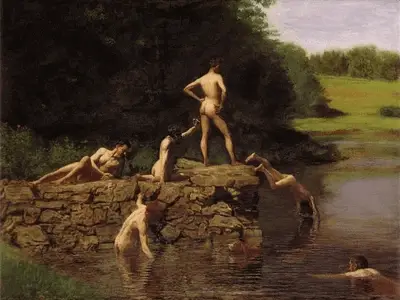Title of Artwork: “The Swimming Hole”

Artwork by Thomas Eakins
Year Created 1883
Summary of The Swimming Hole
The Swimming Hole is Eakins’ most brilliant portrayal of the nude form; it depicts the artist and five other naked men, his students and friends, by the edge of a creek near Philadelphia.
Philadelphia industrialist Edward H. Coates, who served as Chairman of the Committee on Instruction at the Pennsylvania Academy of the Fine Arts, where Eakins taught for ten years, commissioned the painting.
The patron returned the painting to the artist after it was displayed in the Academy’s 1885 annual exhibition, and in its place he commissioned a less divisive genre picture titled The Pathetic Song (1881).
Eakins’ demands for the study of the nude violated Victorian etiquette, and he was fired from the Academy within months, in 1886. Only once more in his lifetime, at Louisville, Kentucky in 1886, did Eakins show The Swimming Hole publicly after it had become so closely identified with this traumatic period in his career due to its subject matter and provenance. The artist kept it till his death thirty years later.
The Swimming Hole, the painting’s now-famous name, was initially used in 1917, likely at Mrs. Eakins’ suggestion. The artist used the title Swimming and The Swimmers to draw attention not to a specific location, but rather to the activity depicted and the people depicted within it.
Eakins photographed these boys swimming extensively, and his paintings show them as they actually were, without any pretence of romance. Controversy has arisen about the author’s lack of sentimentality and the frankness with which he depicts naked males in a variety of situations.
When you consider that Eakins painted himself into the scene as the figure swimming toward the rock, the paintings take on an even more voyeuristic tone. More than a century after the artist’s death, the painting continues to spark heated debate over its intended meaning.
Some see it as an innocent depiction of male frivolity and camaraderie, while others see it as an acknowledgement of latent gay desire, while others see it as a celebration of the nude form focusing on muscle, bone, and anatomy.
All About The Swimming Hole
The Amon Carter Museum of American Art in Fort Worth, Texas, is home to Thomas Eakins’s (1844-1916) The Swimming Hole (also known as Swimming and The Old Swimming Hole), Goodrich catalogue #190, from 1884-85.
It is a masterwork of American painting, done in oil on canvas, and depicts six naked men swimming in a lake. It has been deemed “the most perfectly crafted of all his outdoor works” and “probably Eakins’ most accomplished representation of the nude figure” by art historian Doreen Bolger.
The human body has been regarded as the foundation of artist training and the most difficult topic to render in art since the Renaissance, and Eakins made teaching students to draw naked figures the focus of his curriculum at the Pennsylvania Academy of the Fine Arts. This portrait allowed Eakins to show off his expertise in depicting the human figure.
To create this piece, Eakins capitalised on a notable exception from the generally conservative Victorian view of nudity: the widespread acceptance and normalisation of naked swimming among men.
Eakins was the first American artist to depict a public display of nudity in the 19th century. The Swimming Hole expands upon ideas introduced in his previous works, most notably his fascination with depicting buttocks and his tendency to render the human figure gender-neutral.
His earlier works, The Gross Clinic (1875) and William Rush (1877), dealt with similar topics, and his later paintings of boxers (Taking the Count, Salutat, and Between Rounds) and wrestlers (would also deal with similar topics) would continue this line of inquiry (Wrestlers).
Although several Western artists—from Michelangelo to Daumier—had previously depicted male bathers, Eakins’ take on the subject was groundbreaking in the American art world at the time.
The Swimming Hole is “often cited as a great example of homoeroticism in American art,” as one critic put it. Art critic Tom Lubbock wrote the following about Eakins’s work in 2008:
In 1885, Eakins titled the piece Swimming; the following year, he renamed it The Swimmers. When Eakins’s wife, Susan Macdowell Eakins, referred to the painting as “The Swimming Hole” in 1917, a year after her husband’s death, the name stuck.
After four more years, she gave it the title The Old Swimming Hole, after James Whitcomb Riley’s poem of the same name from 1882. The Amon Carter Museum has since returned to Eakins’ original title, Swimming.
Dove Lake is an artificial lake located in Mill Creek outside of Philadelphia, and it is depicted in the painting as Eakins and five friends or pupils go swimming there. Martin A. Berger describes the men’s gazes as “seemingly lost in a meditative moment” as they stare out over the sea.
Because of Eakins’ meticulous work, experts have been able to positively identify every person in the painting. They are (from left to right): Talcott Williams (1849–1928), Benjamin Fox (c. 1865 – c. 1900), J. Laurie Wallace (1864–1953), Jesse Godley (1862–1889), Harry the dog (Eakins’ Irish Setter, c. 1880–90), George Reynolds (c. 1839–89), and Eakins himself.
Several of the men are lounging on a rocky outcrop that was once the site of the demolished Mill Creek mill in the year 1873.
It is the sole trace of civilisation in the work—no shoes, clothes, or bath buildings are evident. The greenery in the background provides a dark background against which the swimmers’ skin tones contrast.
Information Citations:
En.wikipedia.org, https://en.wikipedia.org/.





















